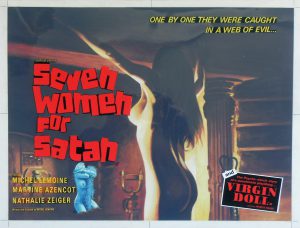Daughters of Lesbos (1968) by #PeterWoodcock
w/ #GeriMiller #LindaBoyce #UtaErickson
"…a lesbian organization dedicated to the proposition that women are superior beings."#1960s #Exploitation #Sexploitation #RapeRevenge#NotQuiteClassicCinema pic.twitter.com/jJxDmHt6sP
— Angus Kohm (@AngusKohm) July 3, 2021
I wrote about a movie called Chained Girls (1965) a little while ago. What I may not have mentioned is that it came to me as part of a double feature DVD released by Something Weird Video. Those who know me, know that I love Something Weird Video, and I have many of their double and triple feature DVDs in my Home Drive-In library. I even have a few old VHS tapes that they put out before DVDs came along. I mainly rented back in those days, because purchasing was expensive, but every now and then I got lucky. What I’m working my way around to saying, is that the second feature on the Chained Girls DVD is a pretty obscure little movie called Daughters of Lesbos (1968).
Daughters of Lesbos is an almost perfect match for Chained Girls as both are politically incorrect 1960s exploitation movies about lesbians. I don’t normally seek out movies about lesbians (although I don’t avoid them, either), but as you may have gathered from my opening paragraph, I will buy (or rent) just about any double or triple feature DVD from Something Weird Video. One thing I love about double and triple features is that if the first movie sucks, then the next one might be better. And vice-versa. But even if they all suck, I somehow feel like I got a better deal buying three bad movies than if I had only bought one. And I believe that a collection which includes EVERYTHING by Herschell Gordon Lewis has more intrinsic value than one with just a few of his best films. But perhaps this is merely revealing a flaw in my character…
I knew nothing about Daughters of Lesbos before getting my hands on this DVD. I also knew nothing about its director, Peter Woodcock (sounds suspiciously like a pseudonym for a guy who only made three movies in his entire career – all of them sexploitation films). Most of the actors are fairly unknown to me as well, although Geri Miller (credited as Dominique in this film) was in 17 things, including Andy Warhol’s Flesh (1968) and The Wall of Flesh (1968) by Joe Sarno. She was also in Andy Warhol’s Trash (1970) and Andy Warhol’s Women in Revolt (1971). Her final appearance seems to have been in Blade (1973), a cop movie that’s sort of like a North American giallo.
Linda Boyce was in 40 movies, mostly sexploitation, including all three of Peter Woodcock’s trashterpieces. Uta Erickson was in 41 films, including several by the legendary team of Michael and Roberta Findley and Love Toy (1971) by Doris Wishman. Uta Erickson was the only name attached to Daughters of Lesbos that I kinda, sorta recognized.
Would I have sought out and watched Daughters of Lesbos if it hadn’t been part of a Something Weird Video set? Probably not. But that’s another benefit of buying a set of films that includes unfamiliar titles. It’s a lot like channel surfing late at night in the 1980s and ’90s. You never knew what you might stumble upon, and I discovered some real gems that way. A lot of those gems were films I never would have chosen to watch if I’d had unlimited options, like on a current day streaming service. Too much choice can be worse than no choice in my opinoiin.
Daughters of Lesbos turned out to be a pretty entertaining 64 minutes of beautifully lit black and white cinematography. The use of light and shadows was stunning in places, and one has to wonder if it was all by design, or simply a product a low budget, limited time and luck. Either way, it’s pretty easy on the eyes. Story-wise, it’s almost like an anthology. Each member of the “Daughters of Lesbos” tells a story about something that happened to her in the past – and more than one involves being raped, or otherwise mistreated by a man. In the end (SPOILER ALERT) they randomly choose one member of their group to exact revenge upon one of the rapists.
It’s pretty simple, and the climactic scene comes really late in the proceedings, but let’s face it – watching a movie like Daughters of Lesbos isn’t about the final destination, it’s about the scenery along the way. And this movie provides plenty eye candy for those with an appreciation for soft core sleaze from another era. The music is great, and the female narrator really elevates the proceedings to an almost poetic, surreal level. One of my Twitter friends (hello Peter!) mentioned that he “got a nuance of Silvia Plath” from it. He also made a great montage that highlights some of the other things I’ve been talking about. You can see it on Twitter.
Sometimes campy, never boring, and, most importantly, at 64 minutes it doesn’t overstay its welcome. If you enjoy this kind of 1960s art-house exploitation, then Daughters of Lesbos (1968) will likely keep you sufficiently diverted for a little over an hour. If, on the other hand, you are easily offended by outdated, politically incorrect material that purports to provide a glimpse into the secret world of lesbians, then you might want to steer clear of this one (and even more so the main feature, Chained Girls). But I think we can all agree that they don’t make this kind of #NotQuiteClassicCinema anymore, and it’s probably best enjoyed alone, or with a like-minded friend, on a #FridayNightAtTheHomeDriveIn.



